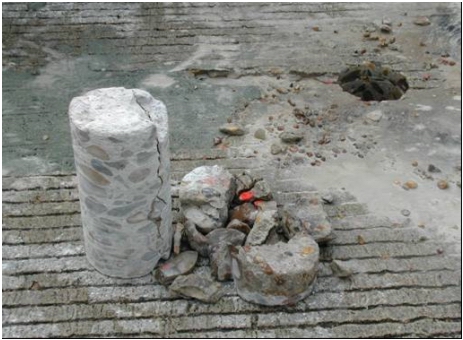The following procedures need to be followed for PDR:
Identify the Repair Limits
When it is determined that PDR is required, it is important to properly evaluate the extent of the spalling and determine the limits of the repair. When spalling occurs, the damage is often extended beyond the visible spalled area. Since most of the spalls that require PDR appear to be caused by shallow delamination, the extent of the delamination needs to be identified. One of the most efficient ways of evaluating the extent of a delamination is the use of a sounding test. A hammer or steel rebar can be used to conduct a sounding test as follows: A hammer or rebar is dropped near the spalls; if there is no delamination, the sound will be solid. On the other hand, a dull or hollow sound indicates a high probability of delamination. Figure 1 shows coring in the spalled area that has been repaired.

The repair material applied (left side of the picture) has a greenish color. A core was taken several inches away from the limits of the spall repair and several delaminations at various depths were observed. Note that the top portion of the core came out disintegrated, which shows an example of a PDR where the limits were not properly identified. A sounding test should have been done and areas with delamination identified, so the area could be included in the repair. To assure removal of all delaminated concrete, it is good practice to extend the limits of the repair boundaries several inches beyond the limits determined by the sounding tests. As mentioned earlier, a research project is currently underway to identify the best method to identify delaminated areas. So far, researchers evaluated ground penetrating radar (GPR) and a portable seismic pavement analyzer (PSPA) for their potential to detect delaminations. Both can detect delaminations. Once the research is complete and more definitive information becomes available, this section will be updated to provide information on which non-destructive testing (NDT) devices can be used for the determination of the delaminated area boundaries.
Remove Deteriorated Concrete
After the repair limits are determined, the delaminated concrete needs to be removed. A typical method for removing spalled concrete is chipping. A shallow vertical saw cut, approximately the depth of the spall, made around the perimeter of the spalled area can be used to prevent a tapering of the repair around the perimeter. Tapering to a shallow depth can contribute to subsequent spalling. Sawing and chipping is sometimes used for large repair areas. As described in the previous section, it is important to remove all the delaminated concrete. Chipping is done with light pneumatic tools.
Clean the Repair Surfaces
For a PDR to succeed, good bonding between the exposed concrete surface and repair material is essential. Without good bonding, the repair material will be separated from the concrete due to environmental and wheel loading stresses. When delaminated concrete is removed, it is important to expose a sound, fresh concrete surface. Fresh concrete surfaces should have rough textures and be cleaned with water to remove any dust to improve bonding of the patching material.
Place the Repair Materials
As described above, a number of different repair materials have been used for PDR. There are different opinions as to which repair materials work best. However, the general characteristics of good repair materials should include:
- good bond strength,
- less volume change potential due to temperature and moisture variations, and
- strength and modulus of elasticity comparable to those of the existing concrete.
When applying the repair materials, it is desirable to screed from the center of the patch out to the patch boundaries. This construction process will improve the bond of the repair materials to the concrete.
Finish the Surface
If cementitious materials are used for PDR, good curing practices are essential. This is because the surface areas and depth of PDR are relatively small, which makes the surface to volume ratio of the repair material applied higher than that of typical concrete pavement. This high surface to volume ratio makes the repair material subject to larger volume changes due to drying shrinkage if moisture is not retained by good curing. The loss of moisture due to poor curing also results in evaporation heat loss. In other words, loss of moisture will result in volume changes in cementitious repair materials. At early ages, the bond strength between repair materials and the concrete surface is not fully developed, and bond failure will occur if volume changes in the repair materials are not controlled.
The optimum time for the application of curing compounds is when the bleed water stops surfacing. However, repair materials for PDR have a low water-cement ratio and there may be no bleed water coming to the surface. In that case, curing operations should start as soon as possible.
References
Original article content and pictures contributed by TxDOT.
